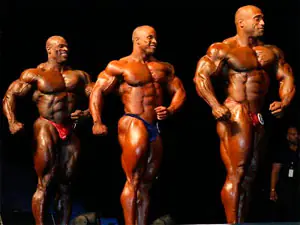Over the past decades of formation and development International Federation of Bodybuilding This organization carried out a colossal amount of work to promote and popularize bodybuilding and other types of “iron sports” around the world. Hundreds of countries, thousands of new sports clubs and dozens of regular annual tournaments - a significant confirmation of this. Every day the structure was more and more clearly built and polished, becoming better, more powerful, more serious day by day.
Having laid the main stone in the foundation, and thereby opening classical bodybuilding to the world community, the rules of competition, in their very first edition, were set out and systematized by the father of modern bodybuilding Joe Weider. Since then, the competitive rules of bodybuilding have undergone an evolution from the initial few sheets of A4 format to a weighty multi-volume book, which takes into account all the possible and impossible nuances of holding competitions. And this process continues its unstoppable development - the current competition program is constantly supplemented with new items and the latest innovations.
A presentation of all available documentation on the conduct of competitions is beyond the scope of this article. We will cite only those points from the rather voluminous rules that directly concern the participants...
Bodybuilding competition rules:
1. Competition program
1.1. The tournament is held in strict accordance with international rules and includes preliminary selection, semi-finals and finals. In the semi-finals and finals, athletes perform compulsory and free programs.
1.2. Competitions for participants in each weight category take place on one day.
2. Tournament participants
2.1. Competitions are held in the following age categories:
I) boys (under 18 years old),
II) juniors (from 18 to 20 years old),
III) adults (21 years of age and older).
2.2. The age of competition applicants is determined by the special regulations on competitions. Admission to the tournament is subject to a doctor’s permission, which is valid for 10 days.
3. Weight categories
3.1. Junior tournaments are held in the following weight categories:
I) lightest weight - up to 65 kg inclusive,
II) light weight - up to 70 kg inclusive,
III) average weight - up to 80 kg inclusive,
IV) heavy weight - over 80 kg.
3.2. Junior tournaments are held in the following weight categories:
I) light weight - up to 70 kg inclusive,
II) average weight - up to 80 kg inclusive,
III) heavy weight - over 80 kg.
3.3. Women's tournaments are held in the following weight categories:
I) light weight - up to 52 kg inclusive,
II) average weight - up to 57 kg inclusive,
III) heavy weight - over 57 kg.
3.4. Men's tournaments are held in the following weight categories:
I) lightest weight - up to 65 kg inclusive,
II) light weight - up to 70 kg inclusive,
III) average weight - up to 80 kg inclusive,
IV) light heavy weight - up to 90 kg inclusive,
V) heavy weight - over 90 kg.
4. Rights and obligations of athletes-applicants
4.1. The athlete has the right to contact the judges on competitive issues only through:
a) team representatives,
b) captain
c) trainer
d) or through a judge assigned to the participants.
4.2. The athlete is obliged to impeccably know and comply with the tournament rules and competition regulations.
4.3. In case of violation of the rules and the established procedure for conducting the competition, the participant is given the first and only warning. In case of repeated violation, the applicant may be excluded (removed) from participation in the tournament by the main panel of judges.
5. Equipment of participants
5.1. Costume
5.1.1. Male applicants must wear swimming trunks of a solid, non-distracting color. Materials with metal, “gold” and “silver” fabrics for evening dresses cannot be used for swimming trunks. The use of padding in swimming trunks is prohibited.
5.1.2. Female participants must wear a bikini that is a solid, non-distracting color. A bikini must expose the abdominal muscles and lower back muscles. Swimsuit clasps must be simple, without ornament. It is prohibited to use materials with metal, “gold” and “silver” fabrics for evening dresses. The use of padding in bikinis is strictly prohibited.
5.1.3. All participants, at the time of performance, must not be wearing:
a) shoes,
b) clock,
c) rings,
d) bracelets,
d) pendants,
e) earrings,
g) wigs
h) and other extraneous accessories.
It is prohibited to use devices to enhance your figure. Participants are strictly prohibited from chewing gum, smoking, or eating candy.
5.1.4. The use of artificial means (canes, hats and other foreign objects) during competitions is prohibited.
5.1.5. The number issued to the competitor must be attached to the left side of the suit.
5.2. Makeup
You can use artificial paint for the body. It is allowed to use oil, cream or various moisturizers within reasonable limits.
5.3. Hairstyle
During preliminary judging, hair must be removed from the shoulders so that it does not cover the muscles of the upper shoulder girdle and upper third of the back. At this stage, a discreet, classic hair styling style is encouraged. For finals, a different hairstyle may be done.
Post Views: 214


